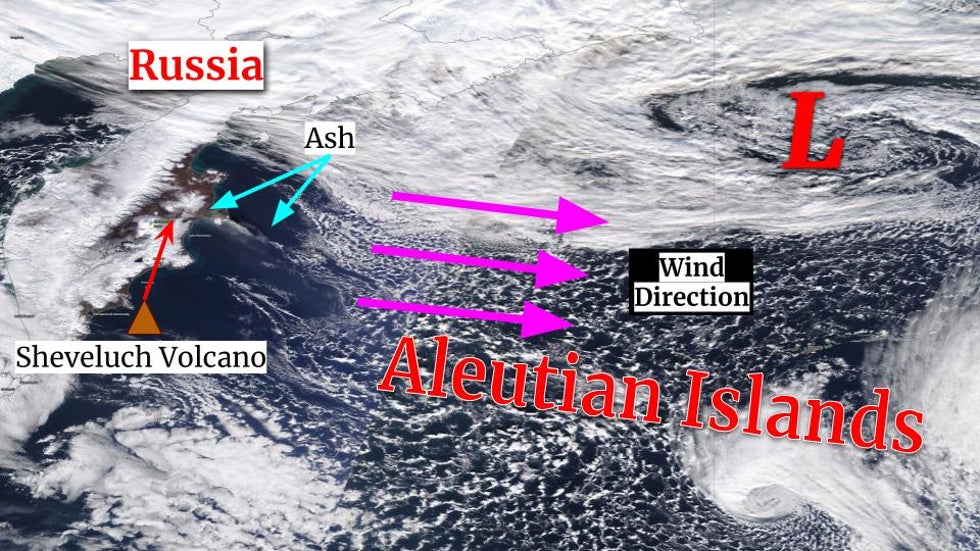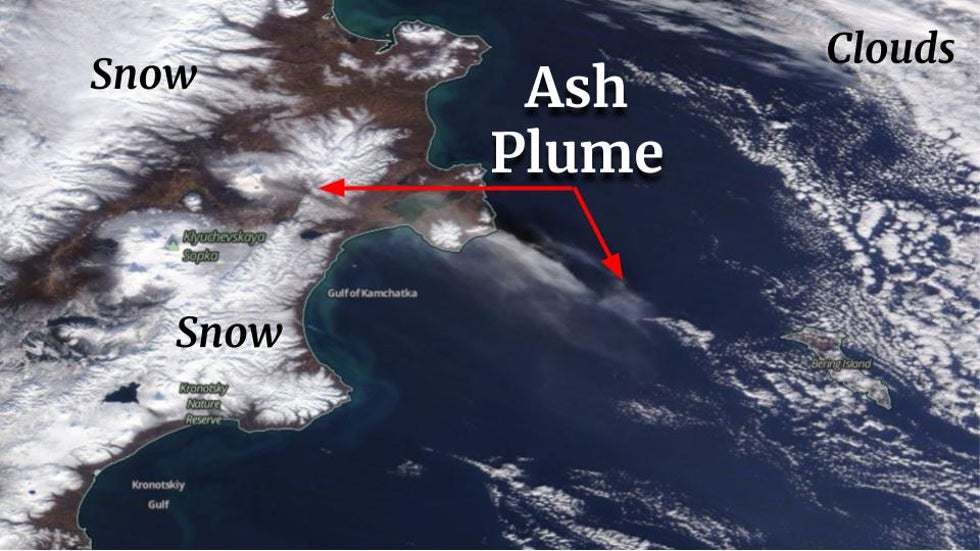The Sheveluch volcano ash plume (in brighter green) was lofted as high as 33,000 feet by early Tuesday morning as it traveled over extreme western portions of Alaska's Aleutian Islands.
Satellites captured ash being whisked away from a Russian volcano on the Kamchatka Peninsula and across the Pacific earlier this week.
The Sheveluch volcano ash plume was lofted as high as 33,000 feet by early Tuesday morning as it traveled over extreme western portions of Alaska's Aleutian Islands. The plume impacted flights Tuesday in the area, according to the Oakland, California, Center Weather Service Unit.
The ash plume (in brighter green) was guided eastward and southward by a strong low-pressure system in the Bering Sea. You can see this system in the loop above by looking for the swirl of deeper clouds (in gold) at the top-center of the image. The plume was relatively thin, producing mainly sulfur-dioxide gas and water particles.
South of the system, winds were sucking air and ash from the northwest toward the southeast over and parallel to the western Aleutians.
The gases traveled at about 40 mph in the western Pacific before accelerating into a rapidly developing low-pressure system in the Gulf of Alaska late Tuesday into early Wednesday.

Zooming in on the early stage of the eruption shows how the deeper, darker plume contrasts with the white snow before the gases become dispersed slightly over the western North Pacific. Some of the heavier materials likely fell out of the plume as it blew eastward, creating the lighter color.

Although this plume was relatively thin, thicker volcanic ash can harm aircraft that fly through the plumes. The ash acts to reduce blade efficiency in airplane engines; mess with temperature and navigation sensors; clog and/or coat engine surfaces needed to push air through an aircraft; and scratch outside surfaces, including wings.
At least 26 ash-related incidents with significant to severe damage have been reported since 1953.
One of the most extensive ash events related to aviation occurred in 2010, when Iceland's Eyjafjallajökull volcano exploded and sent remains of rock and minerals flying into European airspace for nearly a week.
More than 100,000 flights were canceled and 300 airports closed, leading to a loss of $1.7 billion for the airline industry.
The Sheveluch volcano measures nearly 11,000 feet tall and is one of the most active volcanoes in eastern Russia. Sheveluch began erupting in 1999 and has continued since, with intermittent larger explosions like the one witnessed earlier this week.
The Weather Company’s primary journalistic mission is to report on breaking weather news, the environment and the importance of science to our lives. This story does not necessarily represent the position of our parent company, IBM.
The Weather Company’s primary journalistic mission is to report on breaking weather news, the environment and the importance of science to our lives. This story does not necessarily represent the position of our parent company, IBM.

No comments:
Post a Comment